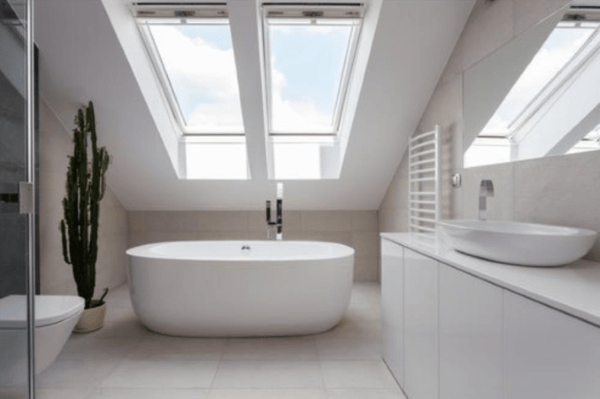In case you missed it see what’s in this section
Let's Talk
Your Total Guide To lifestyle
Freestanding Vs Built-In Bathtubs

Ever stood in the middle of a showroom, scratching your head over the dilemma of freestanding vs built-in bathtubs? The world of tubs can be a puzzling place, especially when both styles keep calling you with their unique charms. Luckily, this article is here to guide you through the sea of choices. And this matters because each style has its own set of perks, and finding the right fit for your space and lifestyle is crucial. After reading this piece, you’ll be able to confidently pick the perfect standing up bathtub that aligns seamlessly with your space and lifestyle.
What is a freestanding Tub?
In the battle of freestanding tub vs built-in, freestanding tubs stand tall, offering unmatched aesthetics and flexibility. They are those elegant, standalone wonders that can transform your bathroom into a place of relaxation. We’re talking about a bathtub that's not just a utility but a piece of art, designed to steal the spotlight in your bathroom..
Dimensions and Styles
A freestanding tub is a complete package, finished on all sides, standing tall without the need for framing or support. They are hefty, often demanding a reinforced floor for a secure setup. The typical dimensions hover around 183 L x 100 W x 79 H cm, but styles vary to suit every taste: Here are a few common styles they come in:
- Japanese Tubs: Perfect for cozy spaces or a minimalist aesthetic.
- Jacuzzi Baths: Take your soak to the next level with water and air jets.
- Infinity Tubs: A design marvel that gives the illusion of an endless pool.
Now, why should you consider a freestanding tub? Here are some advantages of this tub type:
- Sculptural Design: These tubs are a feast for the eyes, sculpted to add elegance and sophistication to your bathroom.
- Easy Installation: Compared to their built-in counterparts, freestanding tubs are a breeze to install.
- Style Versatility: From classic clawfoot charm to modern egg-shaped indulgence, the options are limitless.
- Added Property Value: Your bathroom becomes not just a space for daily routines but a selling point for your home.
Of course, every choice has its considerations. Here's what to keep in mind:
- Weight: Many freestanding tubs are quite heavy, especially the cast iron ones, requiring floor reinforcement.
- Safety Concerns: With their raised sides, small children may face slipping hazards, and the risk of drowning is higher compared to built-in tubs.
- Cost Factor: Quality and aesthetics come at a price, making freestanding tubs generally pricier than their built-in counterparts.
What is a built-in tub?
Unlike their freestanding counterparts, built-in tubs cozy up against your bathroom walls, seamlessly blending form and function. In the world of double-ended baths, built-in tubs carve their niche with practicality, safety, and affordability. Check up some examples here https://www.aquaticabath.co.uk/category/double-ended-bathtubs
Dimensions and Styles
Built-in bathtubs are the embodiment of practicality, with dimensions typically around 178 L x 178 W x 72 H cm. Here's a glimpse of the styles that can grace your bathroom:
- Drop-In Tubs: Sunk into the floor or a specially crafted platform, these tubs offer a seamless, integrated look.
- Shower Baths: Pair these with trendy fittings and stylish screens for a high-end bathroom experience.
- Corner Baths: Triangular wonders, fitting neatly into the corners, optimizing your bathroom layout.
Now, why might a built-in tub be the right fit for you?
- Safety: Their shallower design makes built-in tubs safer, providing an easier grip for a secure bathing experience.
- Affordability: Wallet-friendly without compromising on functionality or style.
- Space Optimization: Opting for a built-in tub frees up precious bathroom real estate for other fixtures like toilets and sinks.
- Accessibility: No acrobatics are needed with these tubs – reaching into grooves and corners is a breeze.
However, it's fair to consider the trade-offs:
- Less Sleekness: Built-in tubs might lack the visual flair and sophistication that freestanding tubs boast.
- Options Limitation: While styles are diverse, they don't match the extensive variety seen in the freestanding tube vs drop-in tub debate.
- Construction Considerations: A lengthier construction process and the need for tile grouting maintenance can be a downside.
What’s the Main Difference Between a Freestanding Tub and a Built-In Tub?
Now that we've waded through the dimensions, styles, pros, and cons of both freestanding and built-in tubs, let's tackle the question lingering in your mind: What's the main difference between a drop-in tub vs freestanding?
It all lies in their placement and aesthetic appeal. Freestanding tubs demand attention as they proudly stand-alone, often becoming the focal point of your bathroom. On the flip side, built-in tubs snugly integrate into your space, emphasizing practicality and seamless design. Think of it as standalone elegance versus integrated functionality.
Determine the statement you want your bathroom to make. Do you envision a sculptural centerpiece or a harmonious blend of fixtures? With these insights, you're equipped to make a choice that aligns with your taste and the soul of your bathroom
Which should you go for?
Here are additional factors that should steer your decision-making process:
- Space Constraints: Assess the size of your bathroom. Freestanding tubs, with their all-around finish, may demand more space, while built-in tubs snugly fit into compact areas, optimizing room layout.
- Remodeling Considerations: If you're planning a bathroom remodel, the choice between freestanding and built-in tubs can influence the overall design. Built-in tubs seamlessly blend with the remodel, while freestanding tubs might require a more deliberate approach.
- Comfort and Ergonomics: Consider how you prioritize comfort. Freestanding tubs often offer a bit more freedom for soaking due to their raised sides, while built-in tubs may provide a cozier feel with their integrated designs.
- Practicality for Shower Additions: If you're eyeing the addition of a shower head, tub diverter valve, riser pipe, or curtain ring, built-in tubs are generally more adaptable to these modifications, offering a practical solution for those who prefer both a bath and a shower in one space.
Conclusion
In the end, the choice between freestanding and built-in baths is a matter of personal taste. Whichever style resonates with your vision, remember, the key lies in clever design choices that elevate the entire bathroom. Whether you opt for a freestanding tub's standalone elegance or a built-in one's seamless integration, an exquisite bathroom enhances the shower and bath experience.
Weather in Bath
Listings
















